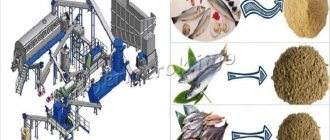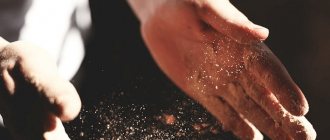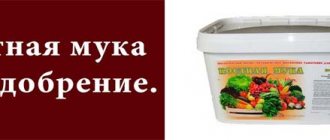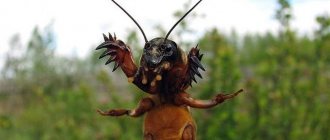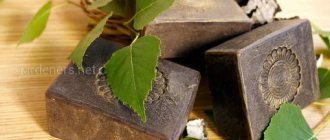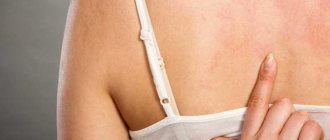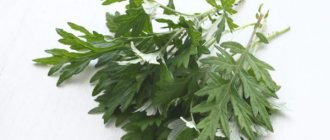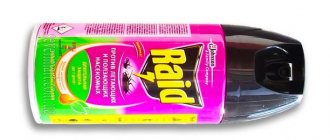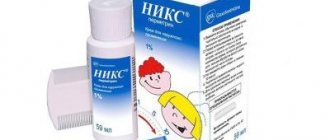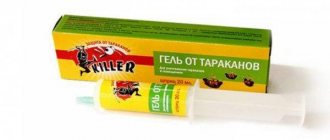Useful components and properties of fish meal
Meal from fish waste is an organic fertilizer, and this is already a big plus, since the absence of potentially dangerous chemical additives greatly expands the possibilities of its use.
On a note! The composition of the product is also very useful, 65% of which is protein, 12-15% is ash and fats, another 8% is polyunsaturated acids, and the remainder is lysine. There are also amino acids, minerals and a whole vitamin cocktail, including representatives of groups A, B and D. There are also valuable minerals, including calcium, iron, nitrogen and phosphorus. True, with long-term storage they all lose their beneficial properties.
If you use a natural, not expired product, you can get a very good harvest, since this flour has the following beneficial properties:
- Significant acceleration of growth and increase in green mass of cultivated crops.
- Promoting abundant flowering and ovary.
- Improving the yield by increasing the mass of fruits and improving their taste.
- Ensuring crop resistance to adverse weather conditions.
The universal composition and high level of safety of the fertilizer allow it to be used to fertilize almost all types of plants. The dry mixture and its fine fraction greatly simplify the use of the product, the feasibility of which largely depends on the purpose.
Storage rules
Features of storing fishmeal depend on the composition of the fertilizer. The most common two types of feeding are fatty (22% fat content) and low-fat flour (up to 10%). For proper storage, the following recommendations should be followed:
It is not advisable to use fatty fishmeal that has been stored open for more than a month. Within 30 days, the amount of crude fat in the composition is reduced to 40%.
- Both types of fishmeal can be stored for 30 days from the moment the package is opened. Humidity should not exceed 14%, and the air temperature should be up to 20 degrees;
- During long-term storage of fatty flour, ammonia may be released. If a strong characteristic odor appears, it is advisable to refuse to use the fertilizer;
- Both fatty and lean fishmeal are not recommended to be stored at low temperatures. This will degrade the quality of the product, and the process of protein breakdown will also begin;
- at high humidity and temperature, the substances included in the fertilizer begin to enter into a chemical reaction, which not only affects the quality of fishmeal, but can also cause harm to the soil. In addition, excessively high temperatures lead to a decrease in the amount of B vitamins and PP in the supplement.
When purchasing fertilizer, it is difficult to monitor compliance with all storage conditions for the fertilizer, so it is advisable to purchase fishmeal only in specialized stores, and also choose a product produced in Peru or Mauritania.
Why use fertilizer
If the soil lacks calcium, it is better to use fish powder made from well-dried bones. Poor flowering, on the contrary, suggests that it is better to use a product made from the soft parts of crustaceans, since they contain more nitrogen. At the same time, it makes sense to apply such fertilizing only after using liquid nitrogen fertilizers in order to improve the absorption of active components.
It is noteworthy that the high content of phosphorus and nitrogen allows the fertilizer to be used not only on private farms, but also on large industrial farms, not only for application to the soil, but also as an additive to the main diet of livestock. It was also noticed that the properties of the fertilizer are revealed to the maximum if it is used not only in combination with nitrogen, but also with wood ash, which is contained in excess in such universal preparations as nitroammophoska.
The only contraindication for using the product is that it cannot be used on soil rich in nitrogen, phosphorus and other active elements contained in flour, in order to avoid oversaturation.
You may be interested in: The most complete calendar of magnetic storms for October 2022 and for the next 3 days. How and with what to cover strawberries in the garden to prepare them for winter 2022. How and when to cover roses for the winter - preparation features and detailed instructions
In addition, it is not recommended to apply fish bone powder in clayey and swampy soils, since such measures will not only not improve the harvest, but will also be detrimental to it.
Remember!
You shouldn’t waste your energy in vain even if you have to deal with sandy soils, since in this case it is difficult for the root system of plants grown on the site to absorb fertilizing.
Errors in using flour fertilizers
Although natural additives are safe and slowly release beneficial substances into the soil, many farmers make a number of common mistakes:
- Exceeding the norms. All fertilizers, even natural ones, must be strictly dosed, since a certain type of soil, a particular crop and climatic zone dictate specific conditions for their use.
- Uncontrolled mixing of several substances. Natural compounds cannot be added in large quantities, mixing everything.
- Use of substandard products. It is not recommended to use flour after the expiration date of the flour due to the loss of a significant part of the nutrients.
How to use fishmeal in the garden
The ideal environment for using flour is black soil, as well as calcareous and loamy soil. As for the effect on plants, the most effective effect of fish bone meal is observed when fertilizing nightshade crops (tomatoes, peppers, eggplants, etc.), potatoes and other root vegetables, which begin to bear fruit worse when a stable calcium deficiency develops.
For potatoes
If the soil lacks calcium and nitrogen (determined by laboratory analysis), fertilizing is applied as the first spring fertilizer. To achieve the most effective result, it is recommended to carry out the manipulation a week before planting potatoes, using 100 grams of raw materials per square meter.
For tomatoes
Unlike potatoes, tomatoes should be fertilized with fishmeal immediately when planting seedlings in the ground. As for the proportions, due to the characteristics of the root system of the crop, it is recommended to use no more than 40 grams of flour for each bush. If you want to get the maximum yield, then rotted chicken droppings should be added to the hole along with the ground bones.
Fruit trees
They love flour from fish skeletons and other waste and fruit and ornamental trees. True, we are talking exclusively about adult plants that do not need such fertilizing during the first year of intensive growth. Also, you should not add flour more often than once every 3 years, using 200 grams of raw materials for each square.
Berry bushes
If there are shrubs growing on the site, then you should not ignore them, especially if the issue of replanting or cuttings is on the agenda. In this case, there are 100 grams of flour per square meter, which are added once a year during the growing season along with bird droppings.
Flower crops
Experienced gardeners note the most beneficial effect that flour from ground bones has on ornamental and bulbous plants. In this case, fertilizing is added to the soil in the spring in an amount of 50 grams per square (relevant for perennial crops). If we are talking about annual plants, then flour is added with each spring digging.
What does organic matter affect, the principle of soil restoration
The most important thing that fishmeal can give to the soil is the restoration of the humus layer with the help of soil microorganisms. If you constantly use mineral fertilizers, their amount gradually decreases, since the soil lacks the necessary organic substances to feed bacteria.
Humus is the main indicator of fertility. On nutritious soils, plants develop better and faster, set more fruits and do not shed them due to nutrient deficiency. Humus contains growth activators that stimulate seed germination and prevent crops from weakening due to unstable environmental conditions.
Together with fishmeal, green manure and ash can be incorporated into the soil. If the soil is acidic, then adding fishmeal will only aggravate the problem, as active oxidation of organic residues will begin. Additions of wood ash neutralize excess acid and restore the natural soil balance.
Norms for applying flour from fish skeletons when planting plants
Having understood the main crops that respond well to mineral-rich flour, it is worth giving some general recommendations on application rates that will help the novice gardener increase his harvest. According to them, organic fertilizer is applied no more than once a year, mainly in spring or autumn. In the first case, flour is added to the holes when planting plants, while in the second it is supposed to be scattered over the ground with further digging, which is carried out two weeks after harvesting.
Pros and cons of fishmeal
Organic composition of fertilizer. Properly processed fish waste does not contain chemicals, which completely eliminates the risk of burns to the root system and fruits of crops grown in the garden or field.
The many useful vitamins, acids and microelements in the composition make even the most meager soil richer, allowing for abundant flowering and fruiting.
Availability. The cost of such organics makes raw materials affordable for any budget. Another thing is that you need to pay attention to its composition, refusing products with a large number of foreign impurities.
Possibility of self-cooking. If fish and seafood are frequent guests on the table, then you should not rush to get rid of the waste left behind. Instead, you can clean them of protein and fat, boil them in unsalted water, dry the resulting semi-finished product in the oven and grind it into powder using a blender or professional coffee grinder.
Flour prepared from fish bones cannot be used in clay soils, as well as in soils with excess nitrogen and phosphorus, which can lead to the development of chlorosis and other dangerous pathologies for plant crops.
Storing powder can also bring a lot of trouble to the farmer, because the longer the raw material sits, the worse its basic qualities become. In addition, it is necessary to provide a special level of temperature and humidity, depending on the fat content of the flour, which is not always possible.
Long-term storage is fraught with a significant decrease in the concentration of useful protein in the raw material. Over time, the volume of protein decreases, and then potentially harmful ammonia appears in the composition.
It affects the safety and content of organic fertilizer at low temperatures, as a result of which its durability is greatly reduced, and this point must be taken into account, never stocking up on flour in advance.
Selection rules
Very often, products based on it are sold under the guise and price of 100% fishmeal. These are various mixtures of fishmeal with plant and animal components, inorganic nitrogen (urea, ammonium nitrate, etc.). Chemical nitrogen artificially increases protein levels, and unscrupulous sellers take advantage of this property. By law, such products must cost less than natural meal and be called a “fishmeal product.”
Such a powder will not cause harm, but there will be significantly less benefit. Supporters of organic farming will not like the chemical content in the fertilizer.
To avoid buying counterfeit products and overpaying, choose a reliable manufacturer with product quality certificates. As a rule, photographs of documents are posted on the company’s website. Flour should not have any foreign odors: mold, mustiness.
Fish powder is a tricky product. If stored incorrectly, mold and ammonia will form in it. A damaged product must not be used.
Storage rules:
- protection from moisture and rodents;
- optimal air humidity up to 75%;
- air temperature no more than 30 °C;
- shelf life 12 months.
Reference! You can buy fishmeal in manufacturers’ online stores. The nutritional composition is also sold in garden stores. There is not only 100% powder, but also fertilizers based on it. Some of them are developed for specific crops and are enhanced with additional nutritional components.
Reviews from gardeners about the use of fishmeal
Nina, Perm: “On the advice of a neighbor, I tried fish powder on the plot, adding it last spring when planting potatoes. The harvest turned out to be excellent, although the autumn application of compost carried out before may have played a role (I have not done this before). This year I want to try it with tomatoes, they say it helps too.”
Angelina, Stary Oskol: “I grow hyacinths, daffodils and tulips in a greenhouse for sale. Last year I added bone meal when digging, I was pleased with the result. This year I repeated the experiment, my handsome ones are already sprouting ears, waiting for their owners.”
Vladimir, Krasnodar: “Never! Never repeat my bitter experience with homemade fish skeleton flour! I always bought it in a universal composition, but last year the devil pulled me to try making it myself. I did everything according to technology, stored it in the basement - there were worms, there was a terrible stench, and then there was fungus, which I whitened out all summer.”
Of course, the quality of the flour will largely depend on what type of fish it was made from, although calcium can be found in the skeletons of any vertebrates. Fishmeal is a simple but useful fertilizer. But it should be remembered that it can only be used on certain types of soil, following the rules and application doses.
Where did this method come from?
Fertilization with fish and fish remains is a method that has proven itself well in the last century. It is not known for certain who came up with the idea of using the remains, but it was definitely noticed that in the places of former reservoirs, vegetable gardens and collective farm fields were more fertile than areas fertilized with manure.
Amateur gardeners who lived during the Soviet Union and state farms located in the Krasnodar Territory and other coastal areas used the cheapest fish to fertilize their lands - anchovy, sprat or sprat. It rotted quickly and was useful. At the same time, the cost of feeding was minimal, because the price of a kilogram of product was low (about 10 Soviet kopecks).
Composition of the product
Recently, gardening has begun to use an unusual fertilizer - fish powder. It is successfully used both in open ground and in greenhouses and greenhouses.
High-protein fish powder is produced from non-edible varieties of fish, fish residues (heads, fins, ridges), crustaceans, and seafood by drying and grinding. Includes:
Important! A low quality product contains insoluble chemical additives, sand, and wood ash. First-class flour consists of 70% protein.
Organic fertilizer can be used for different purposes:
What is the benefit
Fishmeal for agriculture and ordinary summer cottages has many advantages compared to other substances.
Advantages of using fishmeal for plants:
- This product is easier to use and less expensive than manure or manure.
- It is a completely organic substance and does not contain carcinogens or other harmful substances.
- The product increases natural soil fertility. Once applied, it is processed by microscopic organisms in the soil. Flour also has a composition that makes it easier for plants to absorb microelements.
- The fertilizer is absorbed into the soil gradually. There is no risk of overdose or burns to plant roots.
- Fish product perfectly strengthens the immunity of living beings.
- This substance is simple and convenient to store. No special conditions are required for this.
Benefits of using the product for animals:
- Strengthens immunity
- Accelerates growth and development
- Animals become stronger and healthier
- The product is completely absorbed without causing complications
- Meat, milk, eggs and other products from such animals are environmentally friendly, as they do not contain hormones or other artificial additives.
Disadvantages include the low content of microelements and slow action compared to chemical fertilizers. But any chemical preparation will surpass organic fertilizers in terms of the content of various substances.
Advantages and disadvantages of flour fertilizers compared to mineral ones
The industry offers several options:
- bone meal for the garden;
- horned;
- fish;
- fish bone meal;
- blood;
- armored
These natural compounds can fully replace synthetic analogues (superphosphate, ammonium nitrate).
Advantages of bone and other types of meal as fertilizer:
- An alternative to industrial drugs.
- Slow release of active components: they pass into the soil within 6-8 months, which means that the frequency of fertilizing can be once every 1-3 years.
- Environmental friendliness and biosafety - everything unnecessary, except mineral substances, burns during processing.
- Low dissolution rate, which practically eliminates overdose and makes organic fertilizers from bone meal safe in concentration.
- Affordable price.
- Versatility - suitable for most plants, trees and shrubs.
- Possibility of making it yourself
Among the disadvantages of this type of preparation, one can note only the ability to acidify the soil. The way out is simple: on heavy, acidic soils, organic fertilizers made from bone meal are used together with eggshells, lime or chalk.
Global Market Overview
Flour is produced in varying quantities by almost all countries that have sea or ocean borders. Its appearance and quality depend on the type of fauna in a particular fishing zone. For example, Chile uses horse mackerel and anchovy as raw materials, and Japan uses sardines. Peru, Mauritania, Thailand and Morocco are considered the world's largest producers.
First place in the ranking belongs to Peru. But when trying to analyze why the amount of flour products produced annually in this country (more than a million tons) exceeds the volume of live fish caught, a number of questions arise about the use of chemical additives. In second place is Mauritania, which, when processing various varieties of fish, achieves a protein content of 62 to 67%.
Fishmeal is produced in all countries where there is access to the sea or ocean
Imported flour is expensive, so Russian farmers are increasingly inclined to purchase products from domestic producers. Its price is lower, and its quality is practically not inferior to its Chilean and Peruvian counterparts.
Types of bone powder
Depending on the raw materials used, there are different types of flour: bone, blood, fish, shell and horn-hoof. Each option has its own method of application and the result of its impact on the culture. Unlike fish or meat and bone meal, horn chips are suitable for annual plant feeding. The types of fertilizer complement each other perfectly.
Types of organic fertilizer differ in formulation and amount of minerals, as can be seen from the table:
| Product type | Preparation method and composition |
| Bone flour | The substance is made from the skeletons of mostly large animals. Phosphonitrogen is rich in micro- and macroelements, which are quickly absorbed by plants |
| Meat and bone meal | The product is obtained from the carcasses of killed or dead animals. The fertilizer contains protein, which when released into the soil begins to decompose |
| Fish bone meal | The powder is made from the soft tissues and ridges of fish. To prepare it, waste from pollock, anchovy, sardines and other small fish is often used. The product contains a lot of phosphorus and protein |
| Horn-hoof meal | The substance has a high nitrogen content - 8-10%. The powder is prepared from the hooves and horns of mammals. Applying such fertilizer to the soil does not cause burns to the roots, since nitrogen is released slowly |
| The powder is made from the blood of killed animals. It is found on sale much less frequently. It has the highest concentration of nitrogen - about 13%. However, there is very little phosphorus and potassium in the composition | |
| Shell flour | Crustaceans are ground into powder: shrimp, crabs and various crustaceans. The fertilizer contains many minerals that improve soil quality |
Improving soil structure
In addition to being used as plant subcortex, fishmeal can be used to improve the structure of the soil. General guidelines for use include adding powder during autumn digging along with ash and nitrogen-containing minerals (nitroammophos). The product alkalizes the soil much less than bone meal.
If you simply scatter the dry powder on the ground, you should cover it with plant debris. However, such use can cause the appearance of putrefactive bacteria in the soil.
The best method of application: mix flour with wet sawdust (1:1), pour in urea solution (100 g per 10 l) and dig into the ground.
Important! This additive is best used on chernozems, limestones and loams.
On sand, fish powder is poorly absorbed by the roots. Here it is worth using not a dry concentrate, but a liquid complex fertilizer.
On wetlands or clayey lands rich in phosphorus and nitrogen, fertilizer will only cause harm.
You should avoid making common mistakes when using this still rare fertilizer:
Horticulture
Fish powder, like bone meal, is a natural organic fertilizer.
Fishmeal is a multifunctional feed containing all the necessary macro- and microelements. It is used as a fertilizer for garden plants, which accelerates growth and replenishes the lack of essential nutrients.
Using fish powder allows you to get the necessary results:
Important! The biological harmlessness of feeding eliminates the possibility of overdose.
The most noticeable effect of flour on nightshade crops is tomatoes and potatoes.
Tomatoes
When planting a tomato, fish is added under each bush in the amount of 40 grams. To enhance the effect, add a little chicken manure to the hole. Excellent reviews can be heard from gardeners who use their own minced fish. First, 500 g are dissolved in 3 liters of water. This concentrate is diluted again when watering: take 100 g of the mixture per 5 liters.
Tomato is very responsive to phosphorus. There was an article in the periodicals about an Australian farmer who won all agricultural competitions, demonstrating the most delicious and largest tomatoes in the country. For a long time he did not agree to reveal his secret, which turned out to be very simple. When planting tomatoes, he put one small fish in each hole.
Planting seedlings of tomatoes, sweet peppers, eggplants, strawberries, perennial flowers by pouring 3 tbsp into the hole. powder gives excellent results: the survival rate of seedlings increases, intensive growth is observed.
Potato
Fishmeal replaces the use of organic matter and mineral fertilizers in vegetable beds. Plants do not need feeding throughout the growing season, because nutrients are released and absorbed gradually.
For potato fields, fertilizing is applied a few days before planting the tubers, scattering the powder over the surface of the area. Norm – 100 g per 1 sq.m. Potatoes love phosphorus and such fertilizer not only promotes good growth, the formation of more large fruits, but also improves the taste.
cucumbers
Cucumbers are also fed at the time of planting seedlings - 1-2 tbsp. under each bush. Thus, the roots of the plant are directly in the organic powder. But in the case of cucumbers, you should not allow excess fertilizer to be added to the soil. Otherwise, the leaves will turn yellow and the bushes will age prematurely from excess phosphorus.
To feed onions, nitrogen, phosphorus, and potassium are required. It is best to add fishmeal to the soil in advance. However, you can use an aqueous infusion of the powder. Watering 2-3 times per season will supply the vegetable with all the essential macroelements. The powerful leek especially needs intensive feeding.
If emergency nutrition is needed for growing plants, use the following infusion: 0.5 kg of powder is steamed in 10 liters of hot water. Infuse the mixture for a week with regular stirring. The concentrate is filtered and dissolved in a ratio of 1:10.
Root vegetables that do not tolerate the use of organic matter respond positively to fish powder. It does not cause them to bend or branch, and the taste is significantly improved.
Berry bushes
Currants, like other berries, need spring feeding. Flour is scattered when digging the ground in the amount of 100 g per 1 sq.m. together with droppings, manure, humus.
Fruit and other trees need to be fertilized with fish fertilizer only once every 3 years. For 1 sq.m. scatter 200 g of powder.
In the flower garden, perennial bulbous plants should be fertilized with a natural additive. In spring, 50 g of powder per 1 sq.m. is scattered on the garden bed.
Important! Fishmeal has one significant drawback: it takes at least six months for the complete release of nutrients.
This flaw can turn into an advantage, since the need to use fertilizers several times disappears. The prolonged action of the drug reduces labor costs in the garden.
Stern
Fishmeal is also used for animals. In fact, it is the same nutritious product as fish oil, which is used by humans. Fishmeal contains large amounts of protein, amino acids that are not synthesized by animals, but are necessary for them to create proteins. Therefore, regular addition of this product to feed will bring tangible benefits:
- Helps animals gain muscle mass faster
- Strengthens the immune system due to its high selenium content
- Will have a positive effect on growth and development
- Increases the ability of animals to reproduce
It is enough to mix fish meal into the feed once a week at the rate of:
- For cows and cattle – half a kilo per day
- For small animals, this product is added at the rate of 5-7% of the diet
- For poultry – from 2 to 7% of the diet.
Direct drying method
Fishmeal is prepared in special drums with mixing blades. Before loading crushed raw materials, they are heated to a temperature of 85-90 degrees. Initially, the fish is boiled for about half an hour. The duration of hot processing directly depends on the lipid content of the raw material. After cooking is completed, pressure is built up in the drum, which is gradually increased. The drying time is usually about 4 hours, if the fish initially contains 10-12% water.
After the flour is ready, it is removed from the drum with a stirrer and fed to a press to partially remove the fat. The resulting briquettes are crushed in a special mill and passed through magnets to remove any microscopic particles of metal dust. Next, the flour is packed into bags or bags and sent to the warehouse.
